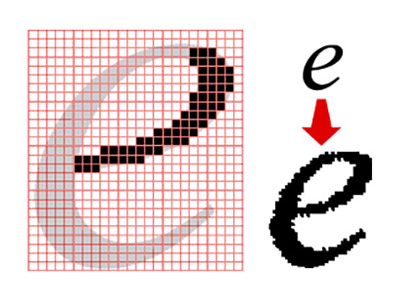ARTWORK GUIDELINES
Ridgeline Signs uses Adobe Creative Cloud products. When sending us files to use in your project, it is important that we have files that are high quality and compatible with our software. We prefer to use the following formats:
.AI
.PDF
.EPS
.SVG
.SKETCH
*300 dpi or higher
.PSD
.TIFF
.JPG
.PNG
.GIF
If you don’t have access to one of the file types listed above, don’t worry! Let us know what you have and we can work with you.
It’s important to note that Word docs, Excel spreadsheets, PowerPoint files, Cricut and many home design and scrapbooking software files will not work. These programs do not create artwork that is of sufficient quality. They also often have specific file extensions that are not compatible with other programs.
What's the difference between Vector and Raster?

Vector
A vector image or graphic is a type of image defined on a plane, connected by lines and curves. They form shapes based on mathematical equations. And because of this, if you zoom in or out, the lines, curves, or points always remain smooth.
Let’s pretend you have a vector image that is 300 x 300.
Because a vector image is made up of mathematical paths, you can increase the size of the image as much as you want and it would never decrease in quality. You could literally increase the size to 3 million x 3 million and all the details would still look sharp (assuming your computer could handle a file that big).

Raster
A raster image is a term in computer graphics and digital photography. A raster, also called a bitmap image, represents a rectangular grid of pixels. They are viewable using a bitmapped display or another medium.
Now, let’s pretend you have a raster image that is 300 x 300.
While it’s easy to make an image smaller, increasing the size usually means decreasing the resolution. As you increase the size of a raster image, it will become fuzzier and more pixelated — it will not look great.
This difference usually makes vector images a superior option, especially when it comes to print. However, there are times when using raster images might be your best option. For example, photographs are always raster images. Converting a photograph to a vector image is possible, but will usually result in a drop in detail.
In this case, you might want to keep your image a raster file. As long as the resolution is at least 300 pixels per inch, your image will be able to be printed just fine.
It’s also common for vector images to be converted to raster images to make them more accessible on the web. For example, the logo in the header at the top of our website is actually a .png file, while the design itself was originally created using a vector editing software. The .png file is very small (73kb) and makes for a quick loading page. But when it comes to printing, we would want to use a vector version of the logo.
If you plan on using a logo, text, or illustration for print, we recommend tracking down a vector version of the artwork if possible. Otherwise, try to get the highest resolution version of the artwork possible.
What ABOUT COLOR?
Vinyl is produced in a select range of PMS (Pantone Matching System) colors, but we can also print in CMYK. We can use either type of product to produce the best results. If you need a specific color to be matched, you will need to provide the PMS number or CMYK code. Let us know if you have any questions about color and we can work with you to get the results that you want.
What ABOUT FONTS?
All fonts and typefaces should be converted to outlines or images. If this is not possible, please let us know and provide us with the font so that we can ensure the right print.
Please note that there is an art charge for clean-up, logo/image re-creation, image composition, logo creation, identity/brand design, custom art, and other design time.
